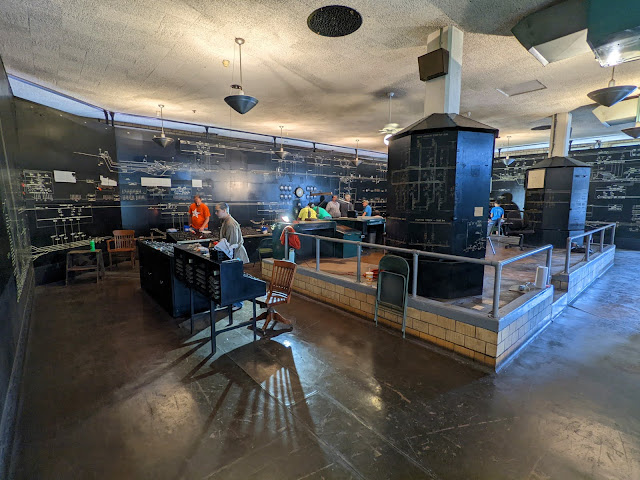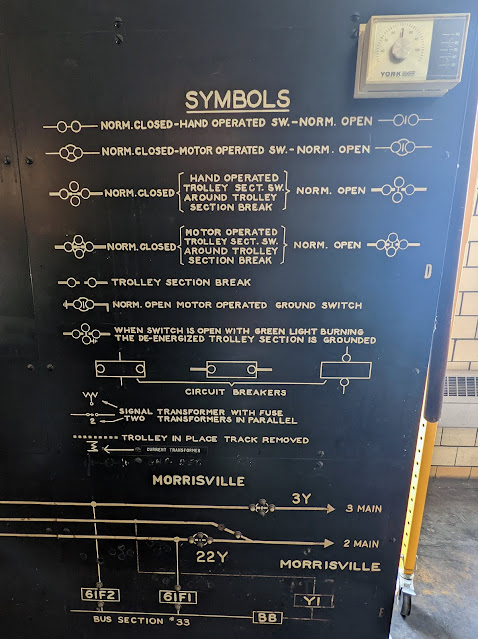Before checking out the Middletown station I stopped by ROY interlocking in Royalton. PA. This was previously the junction between the PRR's Royalton Branch low grade freight line and the Main Line proper. Here Amtrak ACS-86 #636 leads an eastbound Keystone Service trainset with Metroliner Cab Car #9641 through the three-track full crossover.
The Royalton Branch was electrified from 1939 until the end of Conrail electric operations in 1981 and is currently used by road freights to/from Maryland and Delaware that wish to bypass Enola Yard. Today the Royalton Branch is owned an operated by Norfolk Southern for freight purposes making ROY one of the few remaining locations where Amtrak dispatchers control part of an NS line. Here we see the Amtrak style position light signal governing westbound Royalton Branch trains standing in front of the ROY tool house. Despite the station sign, this building was never an interlocking tower.
Across the Swatara Creek, nearly all traces of the old Middletown Station, except for the parking lot, have been removed. The low platform station was of the holdout variety with a single platform and eastbound passengers needing to board across the westbound track, resulting in time penalties and procedural complexity.
The old station had the advantage of providing an easy connection to the Middletown and Hummelstown railroad's tourist operations. When I arrived the M&H had not yet opened for the day. GE 44-ton switcher #1 was coupled to a string of former Lackawanna, MU cars with Western Maryland Alco S6 #151 on an adjacent track.
To find the new station following the M&W westward down Broad Street past Kuppy's Diner.
The new station has a central island platform accessed by one of the trendy track overpasses that give riders the choice of long elevator waits or getting their steps in.
The new platform provides a great view of the M&H interchange track. The hard part is being around when the NS local freight performs its work during the overnight hours.
While I was at the station a westbound Keystone service train arrived with Metroliner Cab Car #9645 and ACS-86 #645.
I also managed to catch the final operational flight of an EC-130J Commando Solo airborne broadcast facility operated by the 193rd Special Operations Wing, Pennsylvania Air National Guard out of the adjacent Harrisburg International Airport. The 193rd Wing had been performing the electronic/psychological warfare mission since 1968, but was shifting to more kinetic covert operations with the MC-130J platform. This EC-130J was en-route to provide special radio broadcasts for the Lancaster County fair near Lititz, PA.
Finally rolling into the lot at HARRIS Tower I was greeted by a westbound NS intermodal train with ET44AC #3669, C44-9W #9396 and C44-9W #9628
Due to all the time spent faffing about at Middletown, I was barely in time to catch the arrival of eastbound Pennsylvanian Train #42, led by P42DC #118.
The mid-day Keystone trainset reposition move took place with ACS-86 #645 and Metroliner #9646.
Next up was another eastbound intermodal with C44-10W #7537 and AC44C6M #4121.
This was followed by a westbound doublestack train with ES44AC #8176 and AC44C6M #4461.
After some time at HARRIS tower, I headed over to the Harrisburg Power Director's office, which is located inside the PRR Harrisburg station, behind this door and up these stairs. In the space that greets you, Power Director's controlled PRR/Penn Central/Amtrak/Conrail electric traction power operations on the lines west of Morrisville, Paoli and Perryville between 1938 and 2013.
Formerly this was the home of the Power Directors for electric power zones 8 and 9. The central podium contained two desks for each zone, although after the cession of electric freight operations under Conrail in 1981, Amtrak would operate both zones with a single power director.
Although Power Director Offices had been built in Philadelphia, New York and Baltimore, Harrisburg was the last and most modern through the use of supervisory control, the predecessor of today's SCADA technology, to give the Power Directors direct control over most substation functions. This eliminated the need to rely on relaying instructions through manned interlocking towers. The relay based telecom style technology remained in service throughout the office's operation and still resides in the space today.
The fully illuminated big board that provided real time status of the electric traction power system across hundreds of track miles of would have been considered a marvel of 1938 technology, however all of the graphics were still painted by hand.
Of course because tech could be finicky, the Directors were also provided with these manually operated carousels that used colored wooden pegs instead of lights.
The board seemed even larger behind the scenes and the office could be fed from either 60hz utility power or 100hz railroad signal power.
I will have the opportunity to go more in detail about the Harrisburg PDO over the course of future visits. However on my way out it was not lost on me that the power office was sitting directly above the old STATE tower that was closed in 2017. If both STATE and HARRIS were restored to the same standard, it would be possible to simulate the totality of the PRR's Harrisburg Station operations.
Here is a photo from the Power Office shortly before in 2008 to show what the big board looks like when fully illuminated.

Next time I'll be back with a trip to Boston and some Baltimore area photos.
Next time I'll be back with a trip to Boston and some Baltimore area photos.


















































